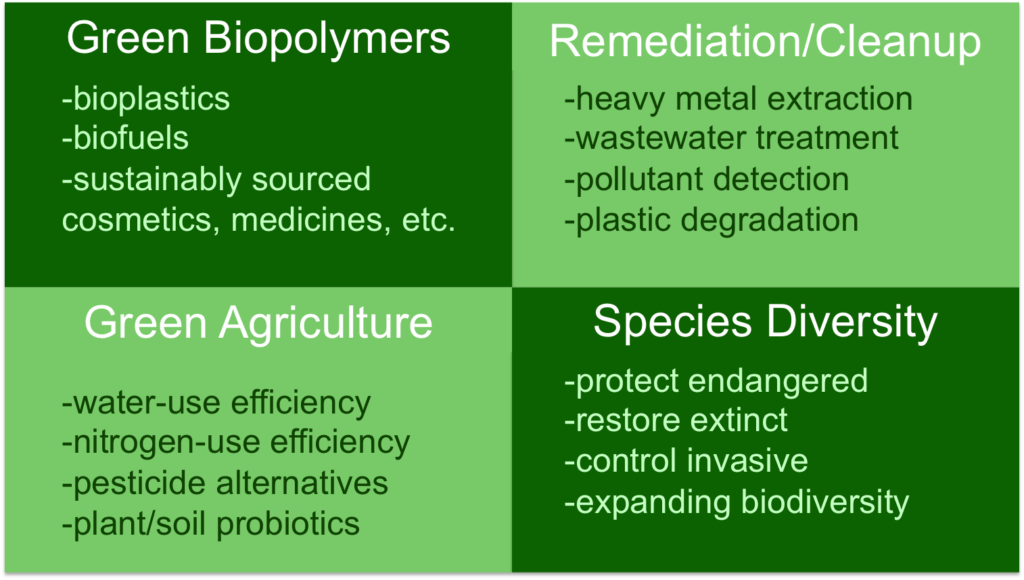Human activity has wreaked havoc on the environment. Many of the products we rely on for our daily lives are sourced from petroleum or made using harsh chemicals that become environmental pollutants. Our land and water is contaminated with the byproducts of manufacturing, mining and excessive plastic waste. Industrialization and exponentially growing populations have shaped agriculture into an intensive industry that relies heavily on water and chemical inputs. The climate is changing and species diversity is shrinking.
These are complex problems, and we’ll need an arsenal of tools to address them. Fortunately, scientists are adding innovative approaches to the toolbox all the time. One of those tools, synthetic biology, is opening doors in environmental science by untangling complicated gene networks.
What is synthetic biology?
Synthetic biology hasn’t attracted a lot of attention, mostly because it’s hard to define.
Broadly, synthetic biology is the application of engineering and computer science to biology. Synthetic biologists probe existing genetic networks to improve our understanding of complex traits like drought tolerance. This is also called systems biology.
But synthetic biologists take that understanding a step further by attempting to build or rebuild genetic pathways in different contexts, such as in a new organism or even outside of living cells. This is also called metabolic engineering.
So really, synthetic biology is systems biology meets metabolic engineering meets computer science. It sounds complicated, but that’s mostly because of the complexity of the problems synthetic biologists are trying to solve.
 Many of the challenges that genetic engineers have tackled up to this point have been relatively simple. To make crops resistant to hungry larvae, or bacteria that can produce human insulin, scientists only had to move one gene.
Many of the challenges that genetic engineers have tackled up to this point have been relatively simple. To make crops resistant to hungry larvae, or bacteria that can produce human insulin, scientists only had to move one gene.
Generating biofuel-producing algae or crops that don’t need fertilizer would require manipulating dozens of genes or even designing new molecular machines that haven’t been found in nature. We’re not there yet, but synthetic biologists are getting closer.
Producing green biopolymers
Traditionally, biopolymers (including fuels and other petroleum-based compounds) have been obtained from natural sources. This requires extraction — mining, drilling, or harvesting from plants and animals — and often, harsh chemicals. For example, chitin, which is used in medicine, food processing, cosmetics and agriculture, is extracted from crustacean shells and has to be chemically treated to achieve the desired structure.
Synthetic biologists are working on developing alternative sources for many polymers. For example, the indigo dye used in blue jeans comes from a petroleum precursor that has to go through a series of treatments resulting in wastewater contaminated with formaldehyde and cyanides. Synthetic biologists at the University of California in Berkeley have figured out how to make the same dye using bacteria.
Other green biopolymers produced by synthetic biology might include biofuels and bioplastics.
 Remediation and cleanup
Remediation and cleanup
Much of our land and water has already become polluted by industrial processes such as the production of polymers or extraction of minerals. Synthetic biology is being used to develop novel approaches for dealing with contaminated waste and cleaning up polluted sites.
For instance, when whiskey is made in copper stills, the resulting spent grains are contaminated with copper ions. Synthetic biologists at the University of Edinburgh are engineering bacteria to convert those copper ions into copper nanoparticles that have biomedical uses. The cleaned-up grains can then be composted or used for animal feed.
Other remediation challenges synthetic biologists are attempting to tackle include heavy metal extraction, wastewater treatment, pollutant detection and plastic degradation.
Greener agriculture
Modern agriculture has become reliant on intense water and chemical inputs. Synthetic biology could be used to develop greener agriculture by improving water or nutrient-use efficiency or developing alternative strategies for pest control.
Scientists at Rice University are using synthetic biology to study how the properties of soil influence bacteria. Their findings could be used to produce probiotics for soil.
Species diversity
Several efforts are underway using synthetic biology to protect and restore species diversity by conserving endangered species, restoring extinct species and controlling invasive species. Synthetic biologists can also help protect biodiversity by making crops and animals more disease-resistant.
Synthetic biology is a key focus of Revive and Restore, an incubator that is focused on using genetic techniques to enhance biodiversity. They’re exploring how synthetic biology can help conserve and restore coral reefs, protect the blackfooted ferret from disease and restore extinct birds.
Becoming an environmental synthetic biologist
The field of synthetic biology is so new that there are few graduate programs in the subject and even fewer undergraduate majors. Because it is an interdisciplinary field, undergraduate students interested in environmental synthetic biology should try to gain training in more than one discipline, including biology, biochemistry, chemical engineering, computer science and environmental science. The International Genetically Engineered Machine (iGEM) competition is also a great way for undergraduate and graduate students to get exposure to synthetic biology.
Those curious about synthetic biology, but not interested in pursuing it as a career, can join their local community biolabs. These not-for-profit organizations provide members with basic lab equipment and training so that they can engage in low budget biology projects. Do-it-yourself biologists at community biolabs are already working on some exciting synthetic biology projects with environmental applications, including the production of vegan cheese.
Undoing the damage of hundreds of years of industrialization is going to take many hands working in many different ways — some of them quite novel. Those interested in environmental science probably don’t intuitively think of synthetic biology, because synthetic sounds like the opposite of natural. But synthetic biology can help us make the most of nature’s toolbox to create harmony between the environment and our industrial societies.

 Remediation and cleanup
Remediation and cleanup